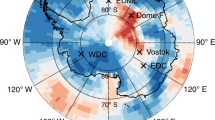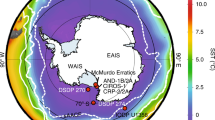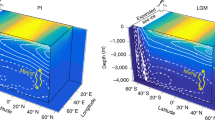Abstract
Ocean–atmosphere interactions in the tropical Pacific region have a strong influence on global heat and water vapour transport and thus constitute an important component of the climate system1,2. Changes in sea surface temperatures and convection in the tropical Indo-Pacific region are thought to be responsible for the interannual to decadal climate variability observed in extra-tropical regions1,3, but the role of the tropics in climate changes on millennial and orbital timescales is less clear. Here we analyse oxygen isotopes and Mg/Ca ratios of foraminiferal shells from the Makassar strait in the heart of the Indo-Pacific warm pool, to obtain synchronous estimates of sea surface temperatures and ice volume. We find that sea surface temperatures increased by 3.5–4.0 °C during the last two glacial—interglacial transitions, synchronous with the global increase in atmospheric CO2 and Antarctic warming, but the temperature increase occurred 2,000–3,000 years before the Northern Hemisphere ice sheets melted. Our observations suggest that the tropical Pacific region plays an important role in driving glacial—interglacial cycles, possibly through a system similar to how El Niño/Southern Oscillation regulates the poleward flux of heat and water vapour.
This is a preview of subscription content, access via your institution
Access options
Subscribe to this journal
Receive 51 print issues and online access
$199.00 per year
only $3.90 per issue
Buy this article
- Purchase on Springer Link
- Instant access to full article PDF
Prices may be subject to local taxes which are calculated during checkout



Similar content being viewed by others
References
Cane, M. A role for the tropical Pacific. Science 282, 59–61 (1998)
Pierrehumbert, R. Climate change and the tropical Pacific: The sleeping dragon wakes. Proc. Natl Acad. Sci. 97, 1355–1358 (2000)
Hoerling, M., Hurrell, J. & Xu, T. Tropical origins for recent North Atlantic climate change. Science 292, 90–92 (2001)
Broecker, W. Paleocean circulation during the last deglaciation: a bipolar seesaw? Paleoceanography 13, 119–121 (1998)
CLIMAP Project Members. Seasonal reconstructions of the Earth's surface at the last glacial maximum. Geol. Soc. Am. Map Chart Ser. MC-36, 1–18 (1981)
Lea, D., Pak, D. & Spero, H. Climate impact of late Quaternary equatorial Pacific sea surface temperature variations. Science 289, 1719–1924 (2000)
Guilderson, T., Fairbanks, R. & Rubenstone, J. Tropical Atlantic coral oxygen isotopes; glacial-interglacial sea surface temperatures and climate change. Mar. Geol. 172, 75–89 (2001)
Bacastow, R. The effect of temperature change of the warm surface waters of the oceans on atmospheric CO2 . Glob. Biogeochem. Cycles 10, 319–333 (1996)
Cane, M. & Clement, A. Mechanisms of Global Climate Change at Millennial Time Scales AGU Geophysical Monograph 112 (eds Clark, P., Webb, R. & Keigwin, L.) 373–383 (American Geophysical Union, Washington DC, 1999)
Broecker, W. & Henderson, G. The sequence of events surrounding Termination II and their implications for the cause of glacial-interglacial CO2 changes. Paleoceanography 13, 352–364 (1998)
Shackleton, N. The 100,000-year ice age cycle identified and found to lag temperature, carbon dioxide, and orbital eccentricity. Science 289, 1897–1902 (2000)
Steig, E. et al. Synchronous climate changes in Antarctica and the North Atlantic. Science 282, 92–95 (1998)
Lea, D., Mashiotta, T. & Spero, H. Controls on magnesium and strontium uptake in planktonic foraminifer determined by live culture. Geochim. Cosmochim. Acta 63, 2369–2379 (1999)
Elderfield, H. & Ganssen, G. Past temperature and δ18O of surface ocean waters inferred from foraminiferal Mg/Ca ratios. Nature 405, 442–445 (2000)
Hastings, D., Kienast, M., Steinke, S. & Whitko, A. A Comparison of three independent paleotemperature estimates from a high resolution record of deglacial SST records in the tropical South China Sea. Eos 82, PP12B-10 (2001)
Rosenthal, Y., Lohmann, G., Lohmann, K. & Sherrell, R. Incorporation and preservation of Mg in Globigerinoides sacculifer: Implications for reconstructing the temperature and 18O/16O of seawater. Paleoceanography 15, 135–145 (2000)
Farrell, J. & Prell, W. Climatic change and CaCO3 preservation: An 800,00 year bathymetric reconstruction from the central equatorial Pacific Ocean. Paleoceanography 4, 447–466 (1989)
Martinson, D. et al. Age dating and the orbital theory of the ice-ages: development of a high-resolution 0-300,000 year chronostratigraphy. Quat. Res. 27, 1–29 (1987)
Schrag, D., Hampt, G. & Murray, D. Pore fluid constraints on the temperature and oxygen isotopic composition of the glacial ocean. Science 272, 1930–1932 (1996)
Epstein, S., Buchsbaum, R., Lowenstam, H. & Urey, H. Revised carbonate-water isotopic temperature scale. Geol. Soc. Am. Bull. 64, 1315–1325 (1953)
Broecker, W. Mountain glaciers: Recorders of atmospheric water vapor content. Glob. Biogeochem. Cycles 11, 589–597 (1997)
Petit, J. et al. Climate and atmospheric history of the past 420,000 years from the Vostok ice core, Antarctica. Nature 399, 429–436 (1999)
Hastenrath, S. On meridional heat transports in the world ocean. J. Phys. Ocean. 12, 922–927 (1982)
White, W. B. & Peterson, R. An Antarctic circumpolar wave in surface pressure, wind, temperature and sea-ice extent. Nature 380, 699–702 (1996)
Koutavas, A., Lybch-Stieglitz, J., Marchitto, T. M. & Sachs, J. El Niño-like pattern in ice age tropical Pacific sea surface temperature. Science 297, 226–230 (2002)
Stott, L., Poulsen, C., Lund, S. & Thunell, R. Super ENSO and global climate oscillations at millennial time scales. Science 297, 222–226 (2002)
Boyle, E., Labeyrie, L. & Duplessy, J-C. Calcitic foraminiferal data confirmed by cadmium in aragonitic Hoeglundina; application to the last glacial maximum in the northern Indian Ocean. Paleoceanography 10, 881–900 (1995)
Dekens, P. S., Lea, D., Pak, D. & Spero, H. Core top calibration of Mg/Ca in tropical foraminifer: Refining paleotemperature estimation. Geochem. Geophys. Geosyst. 3, 10.1029/2001GC000200 (2002)
Stuiver, M. et al. INTCAL98 Radiocarbon age calibration 24,000 - 0 cal BP. Radiocarbon 40, 1041–1083 (1998)
Guilderson, T., Burckle, L., Hemming, S. & Peltier, W. Late Pleistocene sea level variations derived from the Argentine Shelf. Geochem. Geophys. Geosyst. 1, 10.1029/2000GC000098 (2000)
Bard, E. Correction of accelerator mass spectrometry 14C ages measured in planktonic foraminifer: Paleoceanographic implications. Paleoceanography 3, 635–645 (1988)
Acknowledgements
We thank E. Tappa for technical assistance. This work was supported by the US National Science Foundation (R.T. and L.S.).
Author information
Authors and Affiliations
Corresponding author
Ethics declarations
Competing interests
The authors declare that they have no competing financial interests.
Rights and permissions
About this article
Cite this article
Visser, K., Thunell, R. & Stott, L. Magnitude and timing of temperature change in the Indo-Pacific warm pool during deglaciation. Nature 421, 152–155 (2003). https://doi.org/10.1038/nature01297
Received:
Accepted:
Issue Date:
DOI: https://doi.org/10.1038/nature01297
This article is cited by
-
On the future zonal contrasts of equatorial Pacific climate: Perspectives from Observations, Simulations, and Theories
npj Climate and Atmospheric Science (2022)
-
The historical impact of anthropogenic air-borne sulphur on the Pleistocene rock art of Sulawesi
Scientific Reports (2022)
-
Thermal coupling of the Indo-Pacific warm pool and Southern Ocean over the past 30,000 years
Nature Communications (2022)
-
Seasonal origin of the thermal maxima at the Holocene and the last interglacial
Nature (2021)
-
Abrupt mid-Holocene decline in the Indian Summer Monsoon caused by tropical Indian Ocean cooling
Climate Dynamics (2020)
Comments
By submitting a comment you agree to abide by our Terms and Community Guidelines. If you find something abusive or that does not comply with our terms or guidelines please flag it as inappropriate.



